You might see some Delta Aquariid meteors mixed in with the more plentiful Perseid meteors, any time from early to mid-August. Though, in 2023, the full moon around August 1 will cast its light in the sky for much of the night. But, the 2023 Perseids are gearing up for a good display, with only a small waning crescent moon to interfere, around their peak on the mornings of August 12 and 13. After the Perseids … there will be several more good meteor showers before 2023 ends.
Mid-July to mid-August 2023 meteors … the Perseids
Predicted peak: The peak is predicted** for August 13, 2023, at 7:58 UTC. So the mornings of August 12 and 13 are probably your best bet.
When to watch: The moon will be a waning crescent and 10% illuminated during 2023’s peak of the Perseid meteor shower. It’ll likely enhance your enjoyment of 2023’s Perseids. This shower rises to a peak gradually, then falls off rapidly. And Perseid meteors tend to strengthen in number as late night deepens into the wee hours before dawn. The shower is often best just before dawn.
Radiant: The radiant rises in the middle of the night and is highest at dawn. See chart below.
Nearest moon phase: New moon falls at 9:38 UTC on August 16. There will be a waning crescent moon up during the Perseid’s peak in 2023. It’ll be up there, but not too bright. You might even enjoy the waning crescent as you watch for the Perseids in 2023. (and the Delta Aquariids).
Duration of shower: July 14 to September 1.
Expected meteors at peak, under ideal conditions: Under a dark sky with no moon, skywatchers frequently report 90 meteors per hour, or more. In 2023, the waning crescent moon will not interfere with the meteor shower.
Note: The August Perseid meteor shower is rich and steady, from early August through the peak. The meteors are colorful. And they frequently leave persistent trains. All of these factors make the Perseid shower perhaps the most beloved meteor shower for the Northern Hemisphere.
Read more: All you need to know about Perseid meteors
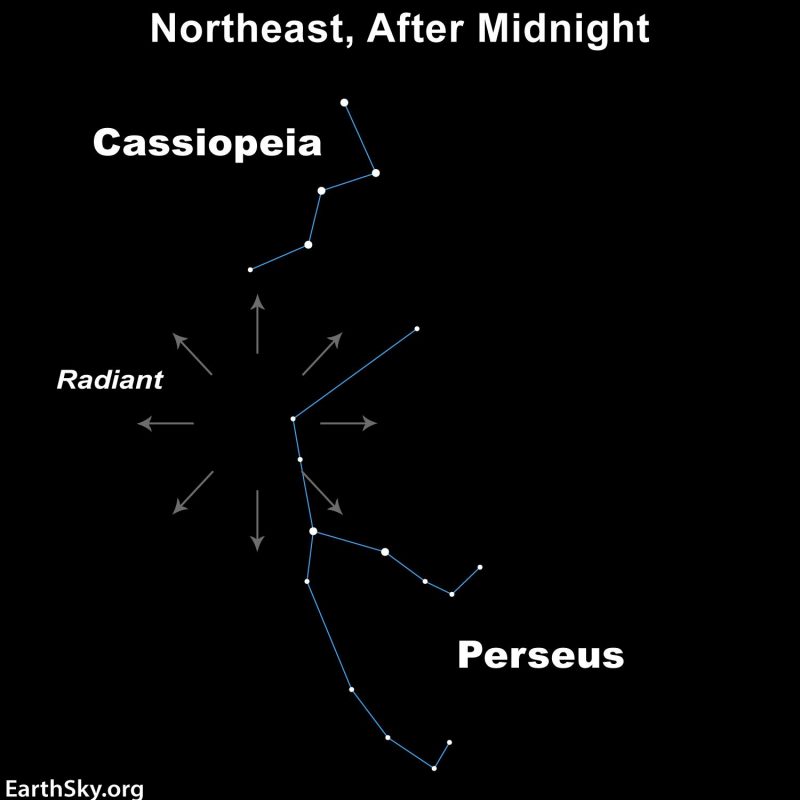
Early October meteors … the Draconids
Predicted peak: The peak is predicted** for October 9, 2023, at 7 UTC.
When to watch: The best time to watch the Draconids in 2023 is the evening of October 8 through the wee hours of the morning on October 9. The waning crescent moon (22% illuminated) will not interfere with most Draconid meteors.
Overall duration of shower: October 8 through 9.
Radiant: Highest in the sky in the evening hours. See chart below.
Nearest moon phase: Last quarter moon is 13:48 UTC on October 6. In 2023, a waning crescent moon will be out on the mornings of October 8 and 9.
Expected meteors at peak, under ideal conditions: Under a dark sky with no moon, you might catch 10 Draconid meteors per hour.
Note: The Draconid shower is a real oddity, in that the radiant point stands highest in the sky as darkness falls. That means that, unlike many meteor showers, more Draconids are likely to fly in the evening hours than in the morning hours after midnight. This shower is usually a sleeper, producing only a handful of languid meteors per hour in most years. But watch out if the Dragon awakes! In rare instances, fiery Draco has been known to spew forth many hundreds of meteors in a single hour. That possibility keeps many skywatchers outside – even in moonlight – during this shower.
Read more: All you need to know about Draconid meteors
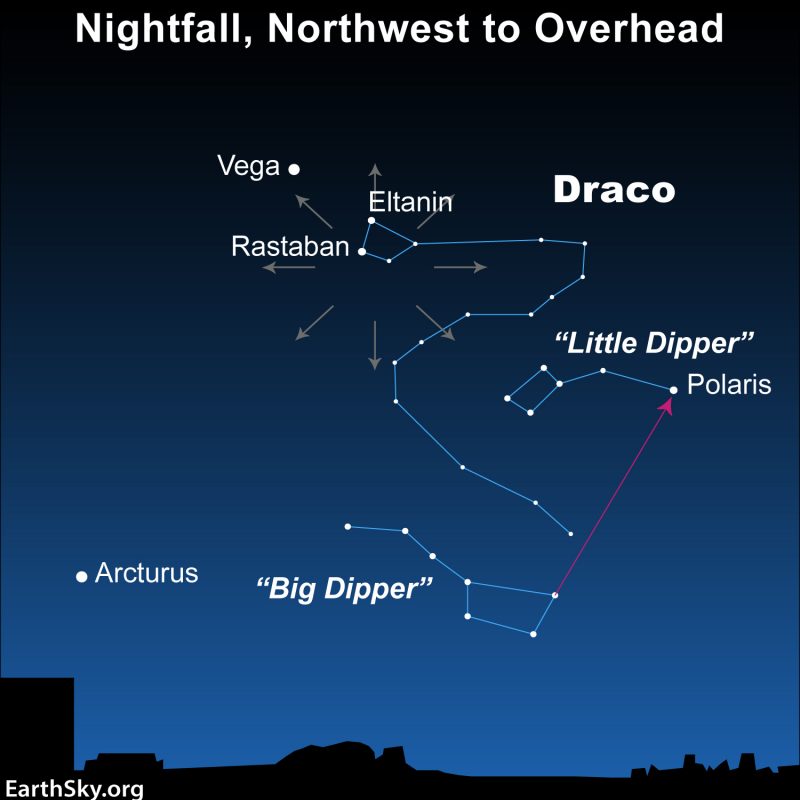
Late October meteors … the Orionids
Predicted peak: The peak is predicted** for October 22, 2023, at 0:05 UTC.
When to watch: Watch for Orionid meteors on both October 21 and 22, in the wee hours after midnight and before dawn.
Overall duration of shower: September 26 to November 22.
Radiant: The radiant rises before midnight and is highest in the sky around 2 a.m. See chart below.
Nearest moon phase: First quarter moon falls at 3:29 UTC on October 22. So, at the Orionids’ peak, the moon will be setting around midnight and not interfere with the meteor shower.
Expected meteors at peak, under ideal conditions: Under a dark sky with no moon, the Orionids exhibit a maximum of about 10 to 20 meteors per hour.
Note: These fast-moving meteors occasionally leave persistent trains. The Orionids sometimes produce bright fireballs.
Read more: Everything you need to know Orionid meteors

October into early November … the South and North Taurids
Predicted peak: The South Taurids’ predicted** peak is November 6, 2023, at 0:47 UTC. The North Taurids’ predicted** peak is November 13, 2023, at 0:21 UTC. Both the South and North Taurids don’t have very definite peaks. They ramble along in October and November and are especially noticeable from late October into early November, when they overlap.
When to watch: Best around midnight, and probably best from late October into early November.
Overall duration of shower: The South Taurids run from about September 23 to November 12. North Taurids are active from about October 13 to December 2.
Radiant: Rises in early evening, highest in the sky around midnight. See chart below.
Nearest moon phase: In 2023, the last quarter moon falls on November 5. New moon is November 13. So late October – when the two showers overlap – will compete with moonlight for the Taurids in 2023. However, near the first predicted peak, the waning gibbous moon will be less bright each night and shouldn’t interfere much with meteors after midnight and before dawn. And the second predicted peak is around new moon. You’ll catch Taurid meteors throughout October and November. Visit Sunrise Sunset Calendars to see moon rising times for your location. Be sure to check the moon rising time box.
Expected meteors at peak, under ideal conditions: Under dark skies with no moon, both the South and North Taurid meteor showers produce about five meteors per hour (10 total when they overlap). Also, watch for fireballs.
Note: Taurid meteors tend to be slow-moving but sometimes very bright. The showers sometimes produce fireballs, which made their cyclical reappearance in 2022. The American Meteor Society pointed to “a seven-year periodicity” with Taurid fireballs. 2008 and 2015 both produced them. 2022 did as well. The Taurid fireball display, in 2015, was really fun! Photos and video of 2015 Taurid fireballs here.
Read more: All you need to know about the Taurid meteors
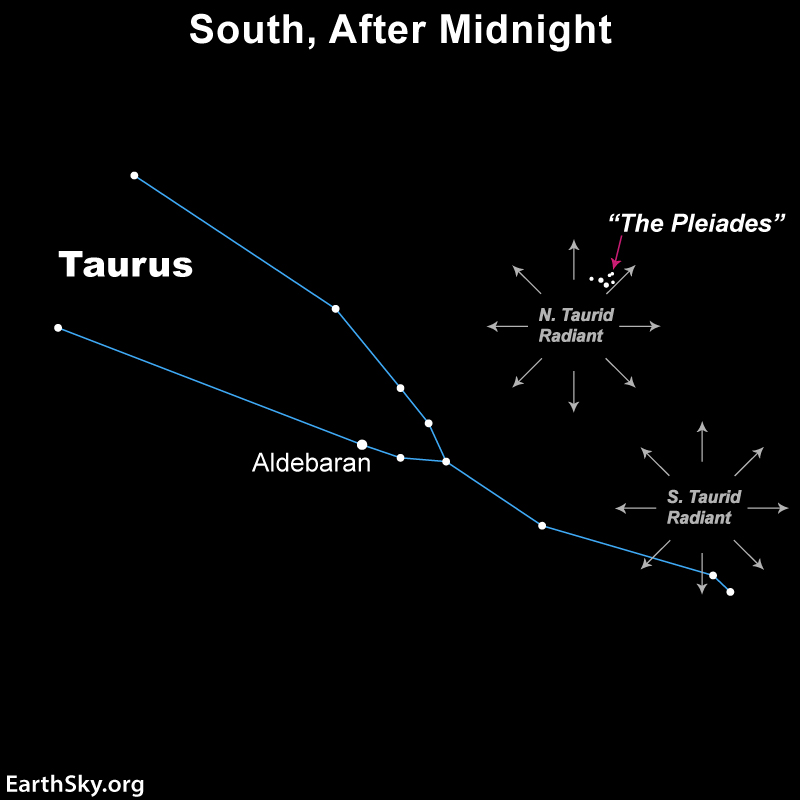
Mid-November meteors … the Leonids
Predicted peak: The peak is predicted** for November 18, 2023, at 5:33 UTC.
When to watch: Watch late on the night of November 17 until dawn on November 18. The morning of November 17 might be worthwhile, too.
Duration of shower: November 3 through December 2.
Radiant: Rises around midnight, highest in the sky at dawn.
Nearest moon phase: In 2023, first quarter moon falls on November 20. So there will be very little interference from moonlight in 2023.
Expected meteors at peak, under ideal conditions: Under a dark sky with no moon, you might see 10 to 15 Leonid meteors per hour.
Note: The famous Leonid meteor shower produced one of the greatest meteor storms in living memory. Rates were as high as thousands of meteors per minute during a 15-minute span on the morning of November 17, 1966. That night, Leonid meteors did, briefly, fall like rain. Some who witnessed it had a strong impression of Earth moving through space, fording the meteor stream. Leonid meteor storms sometimes recur in cycles of 33 to 34 years. But the Leonids around the turn of the century – while wonderful for many observers – did not match the shower of 1966. And, in most years, the Lion whimpers rather than roars.
Read more: All you need to know about Leonid meteors
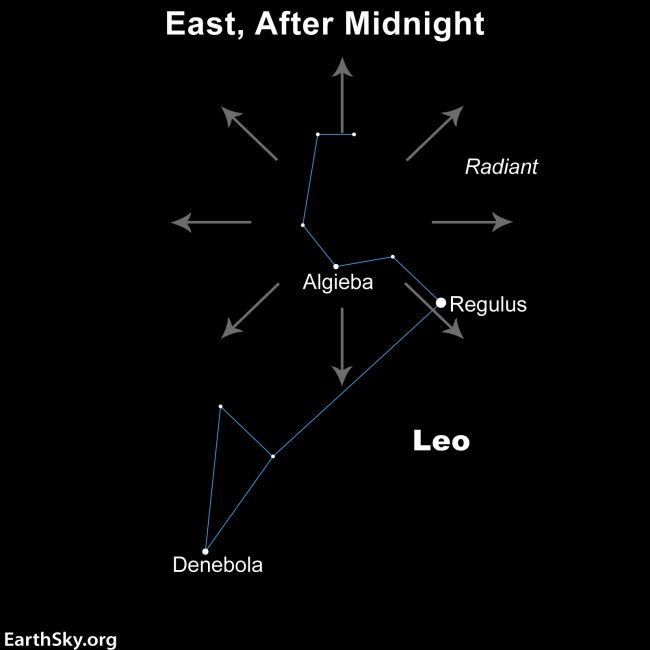
Early to mid-December meteors … the Geminids
Predicted peak: is predicted** for December 14, 2023, at 19:27 UTC.
When to watch: Since the radiant rises in mid-evening, you can watch for Geminids all night around the peak dates of December 13 and 14. Plus, a young waxing crescent moon will not interfere with the Geminids in 2023.
Overall duration of shower: November 19 to December 24.
Radiant: Rises in mid-evening, highest around 2 a.m. See chart below.
Nearest moon phase: In 2023, the new moon falls on December 12. So there will be a dark sky during the peak of the 2023 Geminid meteor shower.
Expected meteors at peak, under ideal conditions: Under a dark sky with no moon, you might catch 120 Geminid meteors per hour.
Note: The bold, white, bright Geminids give us one of the Northern Hemisphere’s best showers, especially in years when there’s no moon. They’re also visible, at lower rates, from the Southern Hemisphere. The meteors are plentiful, rivaling the August Perseids.
Read more: All you need to know about Geminid meteors

Meteor shower around the December solstice … the Ursids
Predicted peak: is predicted** for December 23, 2023, at 4 UTC.
When to watch: Watch for Ursid meteors in the early morning hours of December 22 and 23.
Duration of shower: Ursids range from December 13 to 24, so you might see some intermingling with the Geminids’ peak.
Radiant: Circumpolar at northerly latitudes.
Nearest moon phase: A 1st quarter moon occurs at 18:39 UTC on December 19. So the waxing gibbous moon – at 86% illumination – may interfere with the Ursids in 2023 until the moon sets about three hours before sunrise.
Expected meteors at peak, under ideal conditions: Under a dark sky with no moon, the Ursids offer perhaps five to 10 meteors per hour.
Note: This low-key meteor shower – which always peaks around the solstice – is somewhat overlooked due to the holiday season. Its hourly rate is lower than that of the popular Geminid shower, which peaks just a week before.
Read more: Ursid meteors peak around December solstice

Early January 2024 meteors … the Quadrantids
When to watch: The best night for the 2024 Quadrantids is January 3-4 (The predicted peak** is 12:53 UTC on January 4). A bright last quarter moon will rise around midnight and shine the rest of the night. Try late night January 3 to dawn January 4, in moonlight.
Nearest moon phase: Last quarter moon will come late on January 3, 2024 (CST).
Radiant: Rises in the north-northeast after midnight and is highest up before dawn. The radiant point for the Quadrantids is in a now-obsolete constellation, Quadrans Muralis the Mural Quadrant. Nowadays, we see the radiant near the famous Big Dipper asterism. Because the Quadrantid radiant is far to the north on the sky’s dome, this is mostly a far-northern shower, not as good for the Southern Hemisphere.
Expected meteors at peak, under ideal conditions: Under a dark sky with no moon, when the radiant is high in the sky, the Quadrantids can (briefly) produce over 100 meteors per hour.
Duration of shower: The Quadrantid meteor shower runs from mid-November through mid-January each year, according to this 2017 article in the journal Icarus. You might see a Quadrantid streak by any time during that interval. But most activity is centered on the peak.
Note: The Quadrantid shower is one of four major meteor showers each year with a sharp peak (the other three are the Lyrids, Leonids, and Ursids).
Read more: All you need to know about Quadrantid meteors
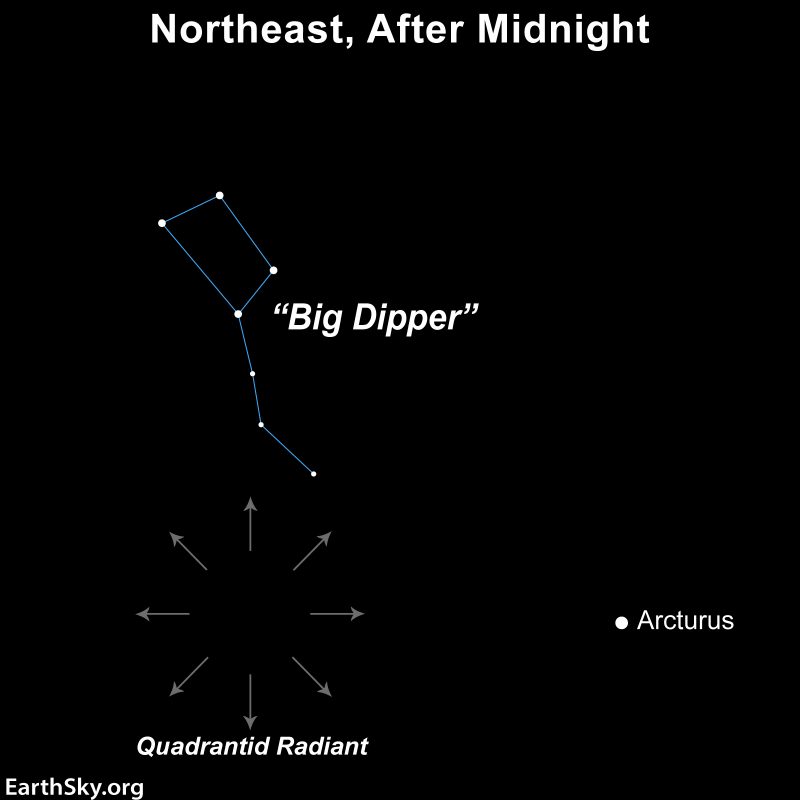
April 2024 meteors … the Lyrids
When to watch in 2024: Late evening April 21 until dawn April 22 will be best. The predicted** peak is 9:23 UTC on April 22. The peak of the Lyrids is narrow (no weeks-long stretches of meteor-watching, as with some showers). In 2024, the full moon falls at 23:49 UTC on April 23. So meteor watching will be impacted by a bright waxing gibbous moon.
Radiant: Rises before midnight, highest in the sky at dawn.
Nearest moon phase: Full moon falls at 23:49 UTC on April 23. So a bright waxing gibbous moon will be in the sky during the peak morning for the 2023’s Lyrid meteor shower.
Duration of shower: April 15 to April 29.
Expected meteors at peak, under ideal conditions: In a dark sky with no moon, you might see 10 to 15 Lyrids per hour. The Lyrids are known for uncommon surges that can sometimes bring rates of up to 100 per hour! Read more about Lyrid outbursts.
Note for Southern Hemisphere: This shower’s radiant point is far to the north on the sky’s dome. So the Southern Hemisphere will see fewer Lyrid meteors. Still, you might see some!
Read more: All you need to know about Lyrid meteors
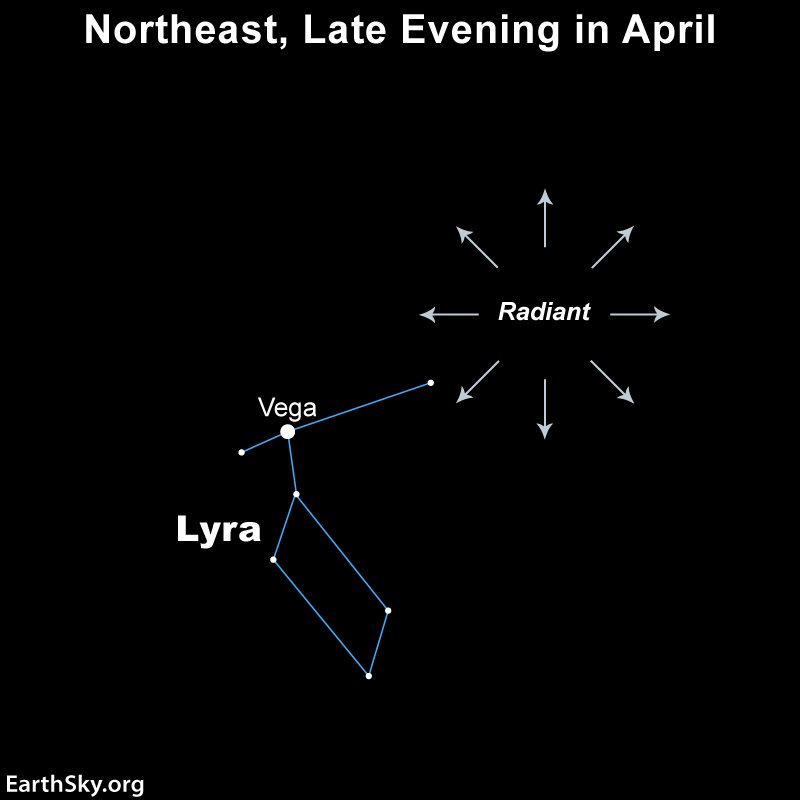
May 2024 meteors … the Eta Aquariids
When to watch: New moon will fall a few days after the peak of the 2024 Eta Aquariid shower. So, mornings around the peak will be dark and moonless. The best mornings to watch are May 5 and 6, 2024, in the hours before dawn. Why before dawn? See “Radiant” below.The American Meteor Society is listing 8:43 UTC on May 5 as the shower’s predicted** peak time. But times vary between different experts. And the peak of this shower stretches out over several days. So you can expect elevated numbers of meteors a few days before and after the peak time.
Nearest moon phase: New moon will fall at 03:22 UTC on May 8. So moonlight will not obscure the 2024 Eta Aquariids.
Radiant: Will rise in the wee hours, climbing toward its highest point at dawn. That’s why before dawn will be the best time to watch this shower.
Duration of shower: April 15 to May 27.
Expected meteors at peak, under ideal conditions: In the southern half of the U.S., you might see 10 to 20 meteors per hour under a dark sky, with no moon, when the radiant is high in the sky. Farther south – at latitudes in the Southern Hemisphere – you might see two to three times that number.
Note: The Eta Aquariids’ radiant will be on the ecliptic, which will ride low in the sky on spring mornings as seen from the Northern Hemisphere. That’s why this shower favors the Southern Hemisphere. It’s often that hemisphere’s best meteor shower of the year.
Read more: All you need to know about Eta Aquariid meteors
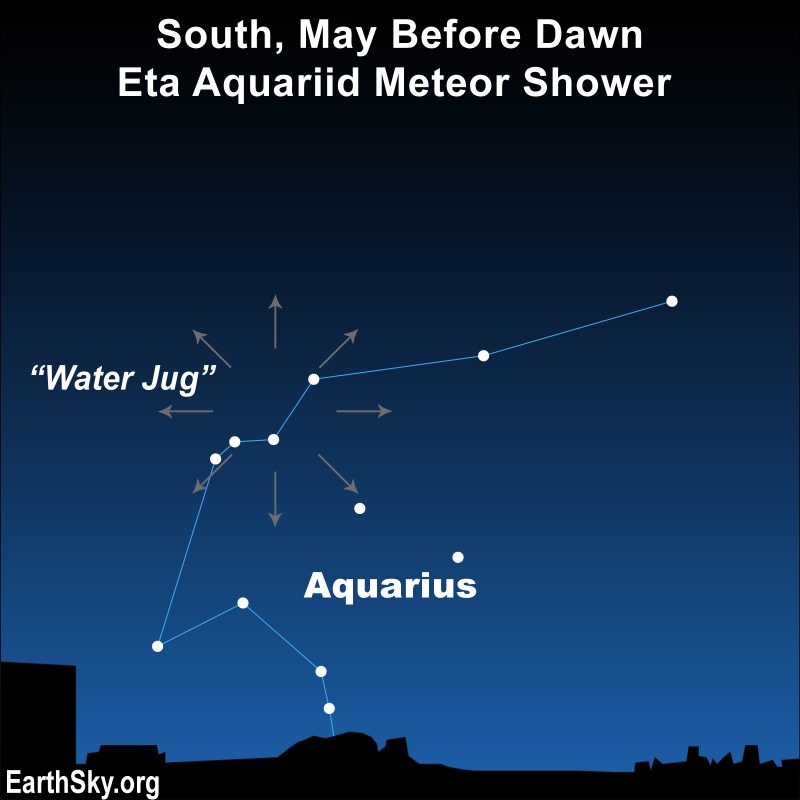
June 2024 daytime meteor shower … the Arietids
Most meteor showers are easy to observe. Just find a dark sky, and look up! But what about meteor showers that happen in the daytime, when the sun is up? The Arietids are sometimes said to be the most active daytime meteor shower. In 2024, their predicted** peak will be the morning of June 7. You might catch some Arietids that morning in the dark hour before dawn.
When to watch: Watch from May 29 to June 17. There’s a predicted** peak on June 7, 2024. Watch for them in the sunrise direction in the dark hour before dawn breaks.
Nearest moon phase: In 2024, a new moon occurs at 12:38 UTC on June 6. So the mornings around the peak will be completely moon free.
Radiant: The shower’s radiant point – the point in the sky from which the meteors appear to radiate – is in the constellation Aries the Ram. You’ll find this constellation in the east before sunrise.
Duration of shower: May 29 to June 17.
Expected meteors at peak: This is tricky for daytime meteor showers because once the sun comes up, you won’t be able to see them. But the Arietids have a strong zenithal hourly rate (ZHR)! Meteor counts with radar and radio echoes have indicated a rate of 60 meteors per hour, and perhaps as high as 200 meteors per hour.
Note: The Arietids are sometimes said to be the most active daytime meteor shower.
Read more: Arietids, most active daytime meteor shower
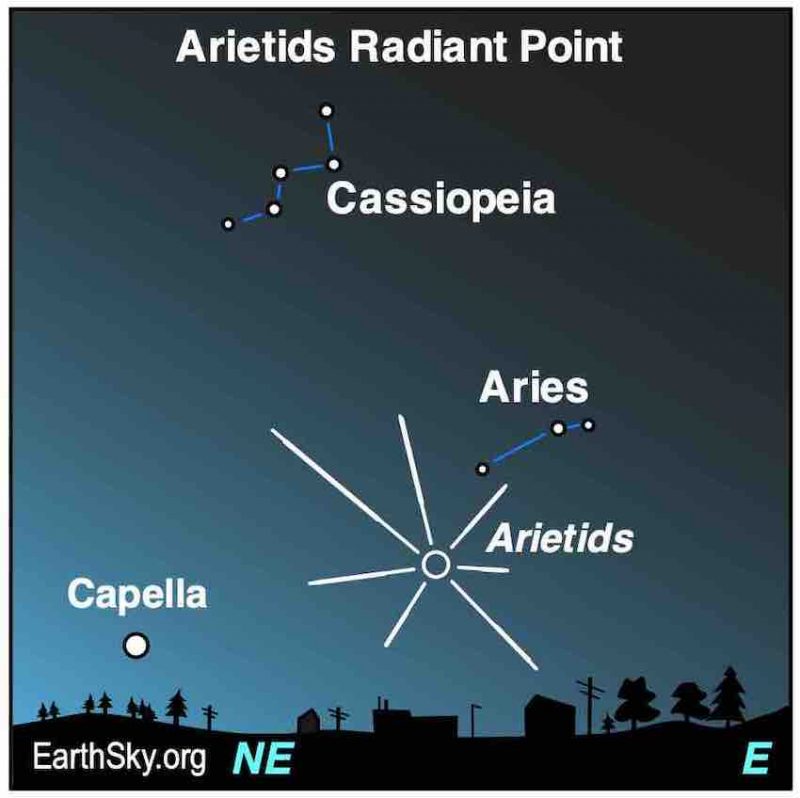
Late July to mid-August 2024 meteors … the Delta Aquariids
Predicted peak: The peak is predicted** for July 30, 2024, at 15:16 UTC. But this shower doesn’t have a noticeable peak. It rambles along steadily from late July through early August, joining forces with the August Perseids.
When to watch: Watch late July through early August, mid-evening to dawn.
Duration of shower: July 18 to August 21.
Radiant: Rises in mid-evening, highest around 2 a.m. and low in the sky by dawn. See chart below.
Nearest moon phase: In 2024, last quarter moon falls at 2:51 UTC on August 1. Take advantage of the moon-free late evenings in late July for watching the Delta Aquariids (and the early Perseids).
Expected meteors at peak, under ideal conditions: The Delta Aquariids’ maximum hourly rate can reach 15 to 20 meteors in a dark sky with no moon. You’ll typically see plenty of Delta Aquariids mixed in with the Perseids, if you’re watching in early August.
Note: Like May’s Eta Aquariids, July’s Delta Aquariids favors the Southern Hemisphere. Skywatchers at high northern latitudes tend to discount it. But the shower can be excellent from latitudes like those in the southern U.S. Delta Aquariid meteors tend to be fainter than Perseid meteors. So a moon-free dark sky is essential. About 5% to 10% of the Delta Aquariid meteors leave persistent trains, glowing ionized gas trails that last a second or two after the meteor has passed.
Read more: All you need to know about Delta Aquariid meteors
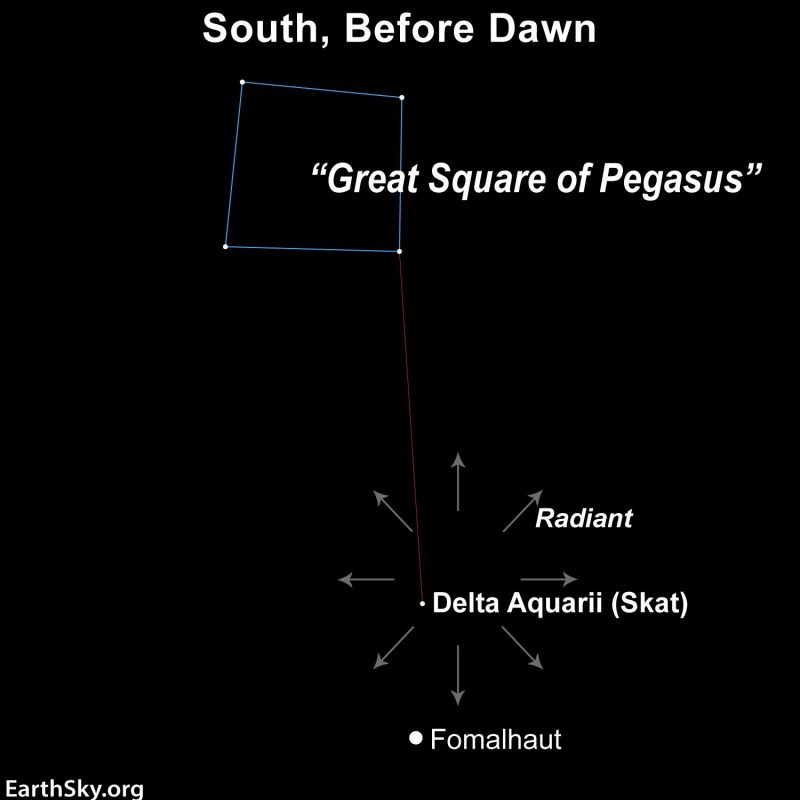
Meteor shower-watching resources
Find a Dark Sky Place, from the International Dark Sky Association
Heavens-Above: Satellite predictions customized to your location
Stellarium Online: Star maps customized to your location
Dark Site Finder, from astrophotographer Kevin Palmer
EarthSky’s tips for meteor-watchers
Why do meteor showers have a radiant point?
Meteor shower guide: photos from the EarthSky community

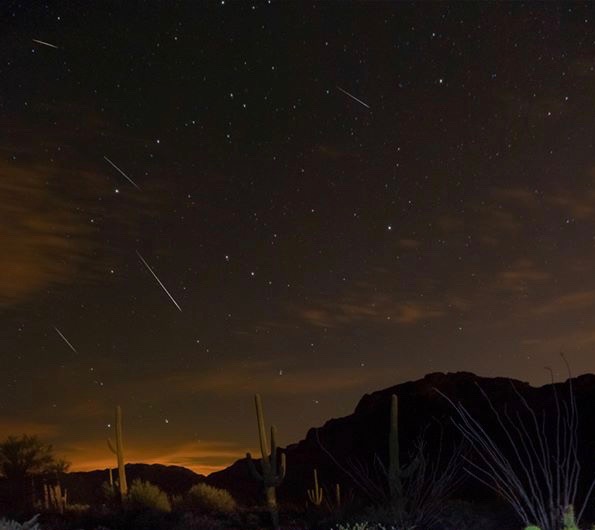
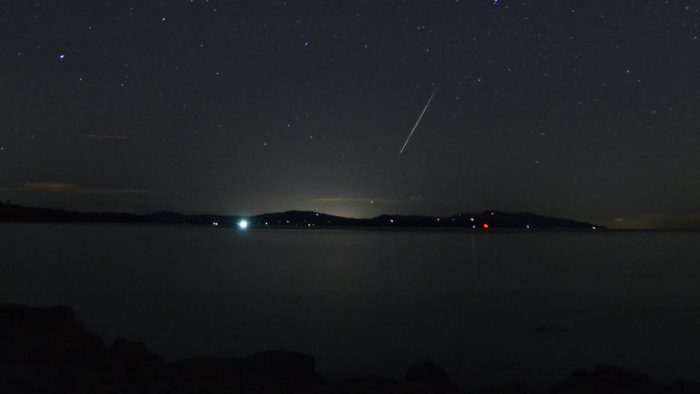
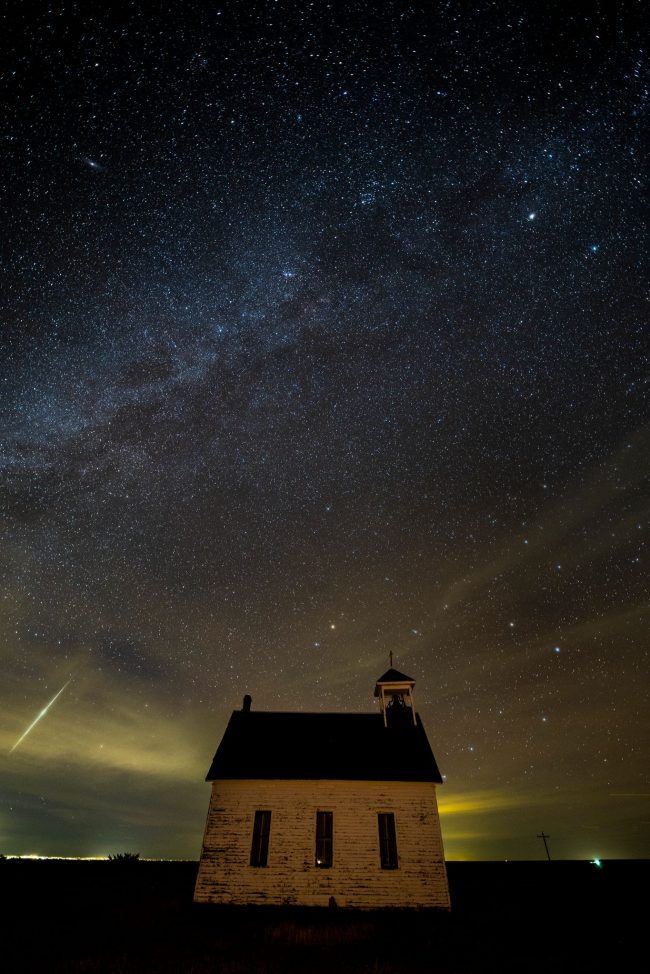
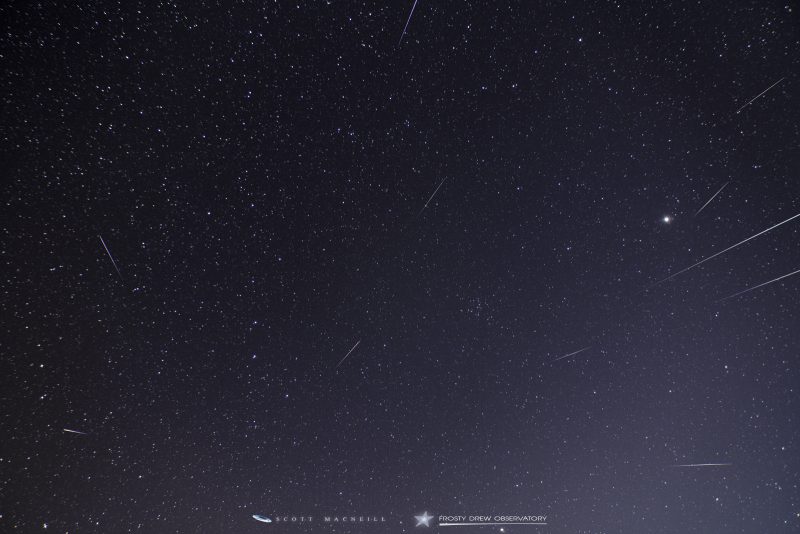
Meteor shower words of wisdom
A wise person once said that meteor showers are like fishing. You go, you enjoy nature … and sometimes you catch something.
Bottom line: Summer meteors are here! Delta Aquariids will blend in with the more active Perseids in early August. Your 2023 meteor shower guide here.
**Peak times for meteor showers provided by Robert Lunsford of the American Meteor Society. Note that predictions for meteor shower peak times may vary. Back to top.
The post Meteor shower guide: Next up the Perseids first appeared on EarthSky.
from EarthSky https://ift.tt/T6t0Nwj
You might see some Delta Aquariid meteors mixed in with the more plentiful Perseid meteors, any time from early to mid-August. Though, in 2023, the full moon around August 1 will cast its light in the sky for much of the night. But, the 2023 Perseids are gearing up for a good display, with only a small waning crescent moon to interfere, around their peak on the mornings of August 12 and 13. After the Perseids … there will be several more good meteor showers before 2023 ends.
Mid-July to mid-August 2023 meteors … the Perseids
Predicted peak: The peak is predicted** for August 13, 2023, at 7:58 UTC. So the mornings of August 12 and 13 are probably your best bet.
When to watch: The moon will be a waning crescent and 10% illuminated during 2023’s peak of the Perseid meteor shower. It’ll likely enhance your enjoyment of 2023’s Perseids. This shower rises to a peak gradually, then falls off rapidly. And Perseid meteors tend to strengthen in number as late night deepens into the wee hours before dawn. The shower is often best just before dawn.
Radiant: The radiant rises in the middle of the night and is highest at dawn. See chart below.
Nearest moon phase: New moon falls at 9:38 UTC on August 16. There will be a waning crescent moon up during the Perseid’s peak in 2023. It’ll be up there, but not too bright. You might even enjoy the waning crescent as you watch for the Perseids in 2023. (and the Delta Aquariids).
Duration of shower: July 14 to September 1.
Expected meteors at peak, under ideal conditions: Under a dark sky with no moon, skywatchers frequently report 90 meteors per hour, or more. In 2023, the waning crescent moon will not interfere with the meteor shower.
Note: The August Perseid meteor shower is rich and steady, from early August through the peak. The meteors are colorful. And they frequently leave persistent trains. All of these factors make the Perseid shower perhaps the most beloved meteor shower for the Northern Hemisphere.
Read more: All you need to know about Perseid meteors

Early October meteors … the Draconids
Predicted peak: The peak is predicted** for October 9, 2023, at 7 UTC.
When to watch: The best time to watch the Draconids in 2023 is the evening of October 8 through the wee hours of the morning on October 9. The waning crescent moon (22% illuminated) will not interfere with most Draconid meteors.
Overall duration of shower: October 8 through 9.
Radiant: Highest in the sky in the evening hours. See chart below.
Nearest moon phase: Last quarter moon is 13:48 UTC on October 6. In 2023, a waning crescent moon will be out on the mornings of October 8 and 9.
Expected meteors at peak, under ideal conditions: Under a dark sky with no moon, you might catch 10 Draconid meteors per hour.
Note: The Draconid shower is a real oddity, in that the radiant point stands highest in the sky as darkness falls. That means that, unlike many meteor showers, more Draconids are likely to fly in the evening hours than in the morning hours after midnight. This shower is usually a sleeper, producing only a handful of languid meteors per hour in most years. But watch out if the Dragon awakes! In rare instances, fiery Draco has been known to spew forth many hundreds of meteors in a single hour. That possibility keeps many skywatchers outside – even in moonlight – during this shower.
Read more: All you need to know about Draconid meteors

Late October meteors … the Orionids
Predicted peak: The peak is predicted** for October 22, 2023, at 0:05 UTC.
When to watch: Watch for Orionid meteors on both October 21 and 22, in the wee hours after midnight and before dawn.
Overall duration of shower: September 26 to November 22.
Radiant: The radiant rises before midnight and is highest in the sky around 2 a.m. See chart below.
Nearest moon phase: First quarter moon falls at 3:29 UTC on October 22. So, at the Orionids’ peak, the moon will be setting around midnight and not interfere with the meteor shower.
Expected meteors at peak, under ideal conditions: Under a dark sky with no moon, the Orionids exhibit a maximum of about 10 to 20 meteors per hour.
Note: These fast-moving meteors occasionally leave persistent trains. The Orionids sometimes produce bright fireballs.
Read more: Everything you need to know Orionid meteors

October into early November … the South and North Taurids
Predicted peak: The South Taurids’ predicted** peak is November 6, 2023, at 0:47 UTC. The North Taurids’ predicted** peak is November 13, 2023, at 0:21 UTC. Both the South and North Taurids don’t have very definite peaks. They ramble along in October and November and are especially noticeable from late October into early November, when they overlap.
When to watch: Best around midnight, and probably best from late October into early November.
Overall duration of shower: The South Taurids run from about September 23 to November 12. North Taurids are active from about October 13 to December 2.
Radiant: Rises in early evening, highest in the sky around midnight. See chart below.
Nearest moon phase: In 2023, the last quarter moon falls on November 5. New moon is November 13. So late October – when the two showers overlap – will compete with moonlight for the Taurids in 2023. However, near the first predicted peak, the waning gibbous moon will be less bright each night and shouldn’t interfere much with meteors after midnight and before dawn. And the second predicted peak is around new moon. You’ll catch Taurid meteors throughout October and November. Visit Sunrise Sunset Calendars to see moon rising times for your location. Be sure to check the moon rising time box.
Expected meteors at peak, under ideal conditions: Under dark skies with no moon, both the South and North Taurid meteor showers produce about five meteors per hour (10 total when they overlap). Also, watch for fireballs.
Note: Taurid meteors tend to be slow-moving but sometimes very bright. The showers sometimes produce fireballs, which made their cyclical reappearance in 2022. The American Meteor Society pointed to “a seven-year periodicity” with Taurid fireballs. 2008 and 2015 both produced them. 2022 did as well. The Taurid fireball display, in 2015, was really fun! Photos and video of 2015 Taurid fireballs here.
Read more: All you need to know about the Taurid meteors

Mid-November meteors … the Leonids
Predicted peak: The peak is predicted** for November 18, 2023, at 5:33 UTC.
When to watch: Watch late on the night of November 17 until dawn on November 18. The morning of November 17 might be worthwhile, too.
Duration of shower: November 3 through December 2.
Radiant: Rises around midnight, highest in the sky at dawn.
Nearest moon phase: In 2023, first quarter moon falls on November 20. So there will be very little interference from moonlight in 2023.
Expected meteors at peak, under ideal conditions: Under a dark sky with no moon, you might see 10 to 15 Leonid meteors per hour.
Note: The famous Leonid meteor shower produced one of the greatest meteor storms in living memory. Rates were as high as thousands of meteors per minute during a 15-minute span on the morning of November 17, 1966. That night, Leonid meteors did, briefly, fall like rain. Some who witnessed it had a strong impression of Earth moving through space, fording the meteor stream. Leonid meteor storms sometimes recur in cycles of 33 to 34 years. But the Leonids around the turn of the century – while wonderful for many observers – did not match the shower of 1966. And, in most years, the Lion whimpers rather than roars.
Read more: All you need to know about Leonid meteors

Early to mid-December meteors … the Geminids
Predicted peak: is predicted** for December 14, 2023, at 19:27 UTC.
When to watch: Since the radiant rises in mid-evening, you can watch for Geminids all night around the peak dates of December 13 and 14. Plus, a young waxing crescent moon will not interfere with the Geminids in 2023.
Overall duration of shower: November 19 to December 24.
Radiant: Rises in mid-evening, highest around 2 a.m. See chart below.
Nearest moon phase: In 2023, the new moon falls on December 12. So there will be a dark sky during the peak of the 2023 Geminid meteor shower.
Expected meteors at peak, under ideal conditions: Under a dark sky with no moon, you might catch 120 Geminid meteors per hour.
Note: The bold, white, bright Geminids give us one of the Northern Hemisphere’s best showers, especially in years when there’s no moon. They’re also visible, at lower rates, from the Southern Hemisphere. The meteors are plentiful, rivaling the August Perseids.
Read more: All you need to know about Geminid meteors

Meteor shower around the December solstice … the Ursids
Predicted peak: is predicted** for December 23, 2023, at 4 UTC.
When to watch: Watch for Ursid meteors in the early morning hours of December 22 and 23.
Duration of shower: Ursids range from December 13 to 24, so you might see some intermingling with the Geminids’ peak.
Radiant: Circumpolar at northerly latitudes.
Nearest moon phase: A 1st quarter moon occurs at 18:39 UTC on December 19. So the waxing gibbous moon – at 86% illumination – may interfere with the Ursids in 2023 until the moon sets about three hours before sunrise.
Expected meteors at peak, under ideal conditions: Under a dark sky with no moon, the Ursids offer perhaps five to 10 meteors per hour.
Note: This low-key meteor shower – which always peaks around the solstice – is somewhat overlooked due to the holiday season. Its hourly rate is lower than that of the popular Geminid shower, which peaks just a week before.
Read more: Ursid meteors peak around December solstice

Early January 2024 meteors … the Quadrantids
When to watch: The best night for the 2024 Quadrantids is January 3-4 (The predicted peak** is 12:53 UTC on January 4). A bright last quarter moon will rise around midnight and shine the rest of the night. Try late night January 3 to dawn January 4, in moonlight.
Nearest moon phase: Last quarter moon will come late on January 3, 2024 (CST).
Radiant: Rises in the north-northeast after midnight and is highest up before dawn. The radiant point for the Quadrantids is in a now-obsolete constellation, Quadrans Muralis the Mural Quadrant. Nowadays, we see the radiant near the famous Big Dipper asterism. Because the Quadrantid radiant is far to the north on the sky’s dome, this is mostly a far-northern shower, not as good for the Southern Hemisphere.
Expected meteors at peak, under ideal conditions: Under a dark sky with no moon, when the radiant is high in the sky, the Quadrantids can (briefly) produce over 100 meteors per hour.
Duration of shower: The Quadrantid meteor shower runs from mid-November through mid-January each year, according to this 2017 article in the journal Icarus. You might see a Quadrantid streak by any time during that interval. But most activity is centered on the peak.
Note: The Quadrantid shower is one of four major meteor showers each year with a sharp peak (the other three are the Lyrids, Leonids, and Ursids).
Read more: All you need to know about Quadrantid meteors

April 2024 meteors … the Lyrids
When to watch in 2024: Late evening April 21 until dawn April 22 will be best. The predicted** peak is 9:23 UTC on April 22. The peak of the Lyrids is narrow (no weeks-long stretches of meteor-watching, as with some showers). In 2024, the full moon falls at 23:49 UTC on April 23. So meteor watching will be impacted by a bright waxing gibbous moon.
Radiant: Rises before midnight, highest in the sky at dawn.
Nearest moon phase: Full moon falls at 23:49 UTC on April 23. So a bright waxing gibbous moon will be in the sky during the peak morning for the 2023’s Lyrid meteor shower.
Duration of shower: April 15 to April 29.
Expected meteors at peak, under ideal conditions: In a dark sky with no moon, you might see 10 to 15 Lyrids per hour. The Lyrids are known for uncommon surges that can sometimes bring rates of up to 100 per hour! Read more about Lyrid outbursts.
Note for Southern Hemisphere: This shower’s radiant point is far to the north on the sky’s dome. So the Southern Hemisphere will see fewer Lyrid meteors. Still, you might see some!
Read more: All you need to know about Lyrid meteors

May 2024 meteors … the Eta Aquariids
When to watch: New moon will fall a few days after the peak of the 2024 Eta Aquariid shower. So, mornings around the peak will be dark and moonless. The best mornings to watch are May 5 and 6, 2024, in the hours before dawn. Why before dawn? See “Radiant” below.The American Meteor Society is listing 8:43 UTC on May 5 as the shower’s predicted** peak time. But times vary between different experts. And the peak of this shower stretches out over several days. So you can expect elevated numbers of meteors a few days before and after the peak time.
Nearest moon phase: New moon will fall at 03:22 UTC on May 8. So moonlight will not obscure the 2024 Eta Aquariids.
Radiant: Will rise in the wee hours, climbing toward its highest point at dawn. That’s why before dawn will be the best time to watch this shower.
Duration of shower: April 15 to May 27.
Expected meteors at peak, under ideal conditions: In the southern half of the U.S., you might see 10 to 20 meteors per hour under a dark sky, with no moon, when the radiant is high in the sky. Farther south – at latitudes in the Southern Hemisphere – you might see two to three times that number.
Note: The Eta Aquariids’ radiant will be on the ecliptic, which will ride low in the sky on spring mornings as seen from the Northern Hemisphere. That’s why this shower favors the Southern Hemisphere. It’s often that hemisphere’s best meteor shower of the year.
Read more: All you need to know about Eta Aquariid meteors

June 2024 daytime meteor shower … the Arietids
Most meteor showers are easy to observe. Just find a dark sky, and look up! But what about meteor showers that happen in the daytime, when the sun is up? The Arietids are sometimes said to be the most active daytime meteor shower. In 2024, their predicted** peak will be the morning of June 7. You might catch some Arietids that morning in the dark hour before dawn.
When to watch: Watch from May 29 to June 17. There’s a predicted** peak on June 7, 2024. Watch for them in the sunrise direction in the dark hour before dawn breaks.
Nearest moon phase: In 2024, a new moon occurs at 12:38 UTC on June 6. So the mornings around the peak will be completely moon free.
Radiant: The shower’s radiant point – the point in the sky from which the meteors appear to radiate – is in the constellation Aries the Ram. You’ll find this constellation in the east before sunrise.
Duration of shower: May 29 to June 17.
Expected meteors at peak: This is tricky for daytime meteor showers because once the sun comes up, you won’t be able to see them. But the Arietids have a strong zenithal hourly rate (ZHR)! Meteor counts with radar and radio echoes have indicated a rate of 60 meteors per hour, and perhaps as high as 200 meteors per hour.
Note: The Arietids are sometimes said to be the most active daytime meteor shower.
Read more: Arietids, most active daytime meteor shower

Late July to mid-August 2024 meteors … the Delta Aquariids
Predicted peak: The peak is predicted** for July 30, 2024, at 15:16 UTC. But this shower doesn’t have a noticeable peak. It rambles along steadily from late July through early August, joining forces with the August Perseids.
When to watch: Watch late July through early August, mid-evening to dawn.
Duration of shower: July 18 to August 21.
Radiant: Rises in mid-evening, highest around 2 a.m. and low in the sky by dawn. See chart below.
Nearest moon phase: In 2024, last quarter moon falls at 2:51 UTC on August 1. Take advantage of the moon-free late evenings in late July for watching the Delta Aquariids (and the early Perseids).
Expected meteors at peak, under ideal conditions: The Delta Aquariids’ maximum hourly rate can reach 15 to 20 meteors in a dark sky with no moon. You’ll typically see plenty of Delta Aquariids mixed in with the Perseids, if you’re watching in early August.
Note: Like May’s Eta Aquariids, July’s Delta Aquariids favors the Southern Hemisphere. Skywatchers at high northern latitudes tend to discount it. But the shower can be excellent from latitudes like those in the southern U.S. Delta Aquariid meteors tend to be fainter than Perseid meteors. So a moon-free dark sky is essential. About 5% to 10% of the Delta Aquariid meteors leave persistent trains, glowing ionized gas trails that last a second or two after the meteor has passed.
Read more: All you need to know about Delta Aquariid meteors

Meteor shower-watching resources
Find a Dark Sky Place, from the International Dark Sky Association
Heavens-Above: Satellite predictions customized to your location
Stellarium Online: Star maps customized to your location
Dark Site Finder, from astrophotographer Kevin Palmer
EarthSky’s tips for meteor-watchers
Why do meteor showers have a radiant point?
Meteor shower guide: photos from the EarthSky community





Meteor shower words of wisdom
A wise person once said that meteor showers are like fishing. You go, you enjoy nature … and sometimes you catch something.
Bottom line: Summer meteors are here! Delta Aquariids will blend in with the more active Perseids in early August. Your 2023 meteor shower guide here.
**Peak times for meteor showers provided by Robert Lunsford of the American Meteor Society. Note that predictions for meteor shower peak times may vary. Back to top.
The post Meteor shower guide: Next up the Perseids first appeared on EarthSky.
from EarthSky https://ift.tt/T6t0Nwj

Aucun commentaire:
Enregistrer un commentaire